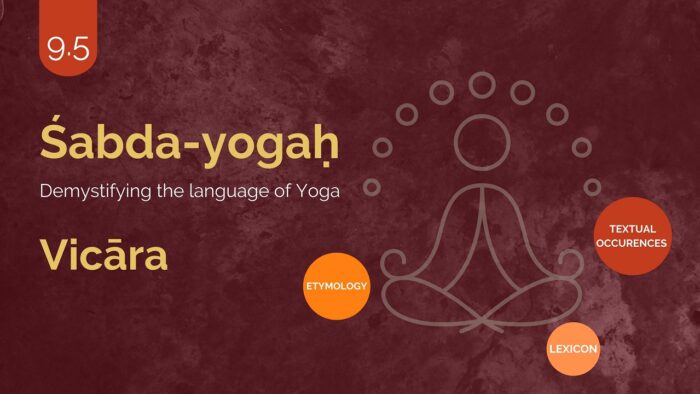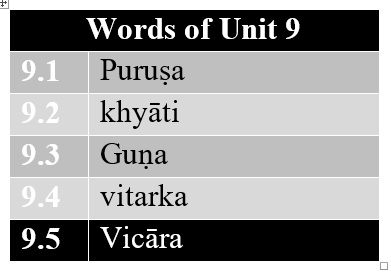Introduction
In this series, Yogic terminologies will be taken up and their –
- Etymological analysis,
- Lexical descriptions and
- Textual occurrences in Yogic literature and their commentaries, as available, will be presented. And finally observations will be made on the references.
Three texts – Yogasūtra, Haṭha-yoga-pradīpikā and Bhagavad-gītā are consulted for textual occurrences portion.
Śabda-yoga is intended to help students, teachers, and professionals of Yoga to develop a sound grammatical, contextual, and thereby an authentic and immersive understanding of Yoga terminologies.
List of Words
From among the above five words for this unit 9, this part discusses the fifth word Vicāra.
Etymology
वि + चर् + घञ् = विचारः
vi + car +ghañ = vicāraḥ
- वि- Vi is the prefix – that means विशेष – special (in the context of the word)
- चर् – Car – is the root that means गति&भक्षण- gati&bhakṣaṇa– to move and to eat
- घञ्Ghañ is the suffix that means भावbhāva – the act. The suffix is added as per the Grammar rule भावेbhāve (अष्टाध्यायीaṣṭādhyāyī3.3.18)
The derivative statement to the word is – विशेषेणचरणंपदार्थादिनिर्णयेज्ञानमिति[1]viśeṣeṇacaraṇaṃpadārthādinirṇayejñānamiti – special movement (of the mind) towards determining the meaning of the word/object – knowledge
Lexicon
In amarakośa one related reference can be found. The connected word isVicāraṇā. Its reference is as follows –
…चर्चासंख्याविचारणा 1.5.2
…carcāsaṃkhyāvicāraṇā
The words –, Carcā,Saṃkhyā, vicāraṇā all relate to analyzing a particular topic with epistemological inputs.
Textual occurrences
Yogasūtra
There are three references to the term Vicāra in Yogasūtra. All the three are found in the first chapter. They are discussed below.
वितर्कविचारानन्दास्मितारूपानुगमात्संप्रज्ञातः॥१.१७॥
vitarkavicārānandāsmitārūpānugamātsaṃprajñātaḥ .. 1.17 ..
एतयैवसविचारानिर्विचाराचसूक्ष्मविषयाव्याख्याता॥१.४४॥
etayaivasavicārānirvicārā ca sūkṣmaviṣayāvyākhyātā .. 1.44..
निर्विचारवैशारद्येऽध्यात्मप्रसादः॥१.४७॥
nirvicāravaiśāradye’dhyātmaprasādaḥ .. 1.47 ..
Sūtra 1.17 discusses the four states of saṃprajñātasamādhi (a state of Samādhi where the mind gets totally identified with the object of focus). Among the four states – Vicāra is the second state. The inputs on the word Vicāra from traditional commentaries are as follows –
- All traditional Commentators accept and follow the view of the principal commentator Vyāsa that the Vicāra stage of Samādhi refers to the subtle (object of focus) (सूक्ष्मोविचारःsūkṣmovicāraḥ– Vyāsa)
- While certain commentators are silent – most commentators are of the views that – while the object of the focus remains the same – Lord Nārāyaṇa (refer śabdayoga 9.4) or such other forms – the complete examining of the subtle building blocks of the self-same object of focus is Vicāra (सूक्ष्मगताशेषविशेषसाक्षात्कारःसविचारइत्यर्थः sūkṣmagatāśeṣaviśeṣasākṣātkāraḥsavicāraityarthaḥ- Vivaraṇa/तत्रैवालम्बनेकारणत्वेनानुगतायेप्रकृतिमहदहङ्कारतन्मात्ररूपाभुतेन्द्रिययोःसूक्ष्माद्यर्थास्तद्गताशेषविशेषसाक्षात्कारेविचारसंज्ञाtatraivālambanekāraṇatvenānugatā ye prakṛtimahadahaṅkāratanmātrarūpābhutendriyayoḥsūkṣmādyarthāstadgatāśeṣaviśeṣasākṣātkārevicārasaṃjñā– Pradīpikā)
- The commentators also agree on the fact that the subtle components of any object of focus –are – the five Tanmātra, the mind, Mahat, Avyakta (Prakṛti) in that order (तत्रैवालम्बनेकारणत्वेनानुगतायेप्रकृतिमहदहङ्कारतन्मात्ररूपाभुतेन्द्रिययोःसूक्ष्माद्यर्थास्तद्गताशेषविशेषसाक्षात्कारेविचारसंज्ञाtatraivālambanekāraṇatvenānugatā ye prakṛtimahadahaṅkāratanmātrarūpābhutendriyayoḥsūkṣmādyarthāstadgatāśeṣaviśeṣasākṣātkārevicārasaṃjñā– Pradīpikā)
- According to Nāgojībhaṭṭa this state of saṃprajñātasamādhi is attained by complete absorption of the mind the nature of the object specified and it is attained by doing dhāraṇā,dhyānaand Samādhi. (धारणादित्रयेणयस्तद्गताशेषसाक्षात्कारःसविचारः – Nāgojībhaṭṭa)
- Yoga Vārttika gives the etymology of the term Vicāra which is worth noting – विशेषेणचरणंसूक्ष्मवस्तुपर्यन्तमितिviśeṣeṇacaraṇaṃsūkṣma-vastu-paryantamiti– the special movement – till the subtlest dimensions of the object.
Thus as evident from the above views of the commentaries – Vicāra in the context of the Samādhis is not intellectual analysis. It is a Yogic activity that involves the process delineated above.
Sūtra 1.44 states two divisions of VicāraSamādhi– Savicāra and nirvicāra. In line with the Savitarka and Nirvitarka states (refer śabdayoga 9.4) – the two Vicāra states are about subtle objects where – in the Svicara the word, object and knowledge will be intermixed. In the Nirvicāra state that object alone will shine forth in the mind – bereft of the connections of word and the knowledge.
Sūtra 1.47 – mentions the term Nirvicāra. Herein, it is stated that when the Nirvicāra state reaches vaiśāradya – excellence adhyātmaprasāda – the knowledge of the consciousness manifests. (SadāśivaBrahmendra- यद्वैशारद्यमभ्यासपाटवेनतस्यप्रधानान्तन्यग्भावाच्चितिशक्तेरुद्वेगः, तस्मिन्सत्यध्यात्मनश्चितिशक्तेःप्रसादःख्यातिर्जायते – yadvaiśāradyamabhyāsapāṭavenatasyapradhānāntanyagbhāvāccitiśakterudvegaḥ, tasminsatyadhyātmanaścitiśakteḥprasādaḥkhyātirjāyate)
Bhagavadgītā –This word is not found this text
Haṭhayogapradīpikā
There is just one related reference in this text. It is as follows –
ब्रह्मचारीमिताहारीत्यागीयोगपरायणः।
अब्दादूर्ध्वंभवेत्सिद्धोनात्रकार्याविचारणा॥१.५७॥
brahmacārīmitāhārītyāgīyogaparāyaṇaḥ .
abdādūrdhvaṃbhavetsiddhonātrakāryāvicāraṇā .. 1.57 ..
Here the expression vicāraṇā is found. Unlike the profound meanings and connotations in the Yogasūtra– here it is evident from the context that – vicāraṇā – refers to enquiry. It is stated that – if one practices celibacy & moderation in eating and has a nature to renounce and be totally dedicated to the practice of Yoga – success is achieved after a year – there is no need to further enquiry (vicāraṇā).
Tabulation of Textual References
Observations
The Śabdayoga analysis on the term Vicāra has revealed that the term vicāra is used in a special sense in the Yogasūtra. While there are no references in Bhagavadgītā, in Haṭhayogapradīpikā a related expression is found (Vicārana) that is totally different from the Yogasūtra connotation.
In the Yogasūtra and the traditional commentaries the following aspects of Vicāra emerged –
1) The etymology of the term Vicāra
2) The subtle objects that are considered under the category of Vicāra – from the Indriyas to avyakta/pradhāna
3) The method of attaining the Vicāra-samādhi – as that of focusing on the subtler aspects of the self-same gross object of meditation taken up earlier in the VitarkaSamādhi
4) The need of dhārana-dhyāna-samādhi steps to attain this Samādhi.
5) The two fold Vicāras – Savitarka and Nirvitarka
6) The outcome of excellence of Nirvicāra state – as that of having the direct perception of the consciousness.
Thus these subtle aspects about the term Vicāra are to be carefully noted and understood in the process of study of the Yoga literature on the states of Samādhi.
[1]https://kosha.sanskrit.today/word/sa/vicAra?q=%E0%A4%B5%E0%A4%BF%E0%A4%9A%E0%A4%BE%E0%A4%B0
Links for previous posts in this unit
Disclaimer: The opinions expressed in this article belong to the author. Indic Today is neither responsible nor liable for the accuracy, completeness, suitability, or validity of any information in the article.













